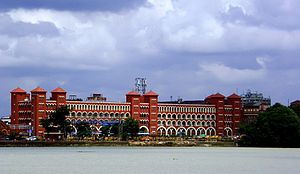Howrah Junction
|
Howrah Junction
|
||||||||||||||||
|---|---|---|---|---|---|---|---|---|---|---|---|---|---|---|---|---|
| Regional rail and Commuter rail station | ||||||||||||||||

Howrah Station, view from Hooghly River
|
||||||||||||||||
| Location | Lower Foreshore Rd, Howrah - 711101 West Bengal India |
|||||||||||||||
| Coordinates | 22°34′54″N 88°20′32″E / 22.5818°N 88.3423°ECoordinates: 22°34′54″N 88°20′32″E / 22.5818°N 88.3423°E | |||||||||||||||
| Elevation | 12 metres (39 ft) | |||||||||||||||
| Owned by | Indian Railways | |||||||||||||||
| Operated by | Eastern Railway and South Eastern Railway Zone | |||||||||||||||
| Line(s) |
Howrah-Delhi main line Howrah-Nagpur-Mumbai line Howrah-Chennai main line Howrah-Allahabad-Mumbai line |
|||||||||||||||
| Platforms | 23 | |||||||||||||||
| Tracks | 25 | |||||||||||||||
| Connections |
|
|||||||||||||||
| Construction | ||||||||||||||||
| Structure type | Standard (on ground station) | |||||||||||||||
| Parking | Available | |||||||||||||||
| Other information | ||||||||||||||||
| Status | Functioning | |||||||||||||||
| Station code | HWH | |||||||||||||||
| Division(s) | Howrah (ER) | |||||||||||||||
| History | ||||||||||||||||
| Opened | 1854 | |||||||||||||||
| Electrified | 1954 | |||||||||||||||
| Previous names | East Indian Railway Company | |||||||||||||||
| Services | ||||||||||||||||
|
||||||||||||||||
Howrah Junction (station code HWH), also known as Howrah Station, is the largest railway complex in India and it is a railway station which serves Kolkata and Howrah, India. Approximately 620 passenger trains pass through the station each day requiring its 23 platforms and a high train handling capacity. Howrah Junction is one of five intercity railway stations serving the city of Kolkata, the others being Sealdah, Santragachi, Shalimar, and Kolkata railway station. The station is located in Howrah on the west bank of the Hooghly River.1273 stations across India are directly connected to Howrah Railway Station.
On 17 June 1851, George Turnbull, the Chief Engineer of the East Indian Railway Company submitted plans for a railway station at Howrah. In January 1852, the government authorities decided not to purchase the land and water frontage needed for the project. However, in May 1852, Turnbull was asked to render detailed plans for the station. The station's estimated cost was 250,000 rupees. In October 1852, four tenders for the building of the station were received. They varied from 190,000 to 274,526 rupees.
In 1901, a new station building was proposed due to increased demand for rail travel. The British architect Halsey Ricardo designed the new station. It was opened to the public on 1 December 1905. This is the current Howrah station building including 15 platform tracks.
In 1969, the first Rajdhani Express left Howrah Junction for New Delhi.
In the 1980s, the station was expanded including 8 new platform tracks on the south side of the station. At the same time, a new Yatri Niwas (transit passenger facility) was built south of the original station frontage.
...
Wikipedia
